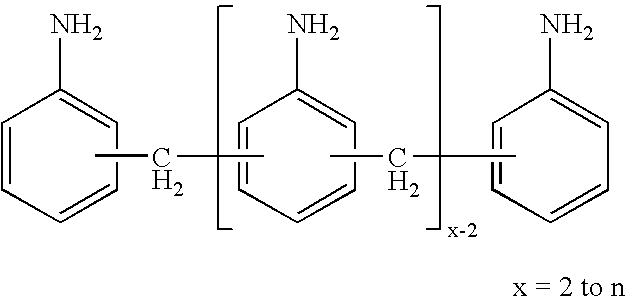Process for the production of very pure 2,4'-methylenediphenyl diisocyanate
- Summary
- Abstract
- Description
- Claims
- Application Information
AI Technical Summary
Benefits of technology
Problems solved by technology
Method used
Image
Examples
example 1 (
Not According to the Invention)
[0070] In step a), 1,000 g of aniline were mixed with 306 g of 31.9% aqueous HCl in a stirred vessel at 40° C. 480 g of 32% formaldehyde solution were added dropwise thereto over 15 minutes. The mixture was first stirred for a further 15 minutes at 40° C., and then the temperature was slowly raised to 100° C. within the next 2.5 hours. The reaction mixture was then stirred under reflux for 10 hours at 100° C. and neutralised with 50% sodium hydroxide solution, the aqueous phase was separated, and the organic phase was washed with water. The organic solution was removed and freed from excess aniline by distillation in vacuo.
[0071] In step b), the MDA reaction product was poured into an ice-cold 15% solution of phosgene in monochlorobenzene (MCB) that was previously placed in a second stirred vessel; the molar excess of phosgene was 200%. The reaction solution was slowly heated within 1 hour to 100° C. under constant addition of 40 litres / hour of phosge...
example 2 (
According to the Invention)
[0080] The process as described above in Example 1 was followed through the completion of step d). From this point on, Example 2 varied from Example 1 as described below.
[0081] The distillate fraction d) from Example 1 was fed in step e) to a further isomer separation by distillation. This glass column contained 10 theoretical plates in the enrichment part and 20 theoretical plates in the stripping part (packing underneath the feed distributor). The fraction d) was metered in continuously at 175° C. between the stripping part and enrichment part. At 3 mbar absolute, 6% of the feed was withdrawn overhead at a reflux ratio of 10. A distillate phase was obtained which contained 36.8% of 2,2′-MDI, 62.4% of 2,4′-MDI and 0.8% of 4,4′-MDI, based on the total weight of the MDI isomers. The distillate phase also contained 0.3% of organic compounds derived from secondary products formed in the MDI production. The bottom fraction e) had the following composition: 0....
example 3 (
Not According to the Invention)
[0083] The fraction e) from Example 1 was highly purified by distillation in step f), and was separated in a further glass column containing 10 theoretical plates in both the stripping part and enrichment part. The fraction e) was continuously metered in at 175° C. between the stripping part and enrichment part. At 3 mbar absolute, 35% of the feed was removed overhead at a reflux ratio of 2 (distillate stream=reflux stream). A distillate phase, the fraction f), was formed as target product, which contained 3.37% of 2,2′-MDI, 95.12% of 2,4′-MDI and 1.51% of 4,4′-MDI, based on the total weight of the MDI isomers. The resulting bottom phase was combined with the crude MDI mixture, the fraction b) in Example 1, and was recycled to the steps c) to f).
PUM
| Property | Measurement | Unit |
|---|---|---|
| Fraction | aaaaa | aaaaa |
| Pressure | aaaaa | aaaaa |
| Pressure | aaaaa | aaaaa |
Abstract
Description
Claims
Application Information
 Login to View More
Login to View More - R&D
- Intellectual Property
- Life Sciences
- Materials
- Tech Scout
- Unparalleled Data Quality
- Higher Quality Content
- 60% Fewer Hallucinations
Browse by: Latest US Patents, China's latest patents, Technical Efficacy Thesaurus, Application Domain, Technology Topic, Popular Technical Reports.
© 2025 PatSnap. All rights reserved.Legal|Privacy policy|Modern Slavery Act Transparency Statement|Sitemap|About US| Contact US: help@patsnap.com


